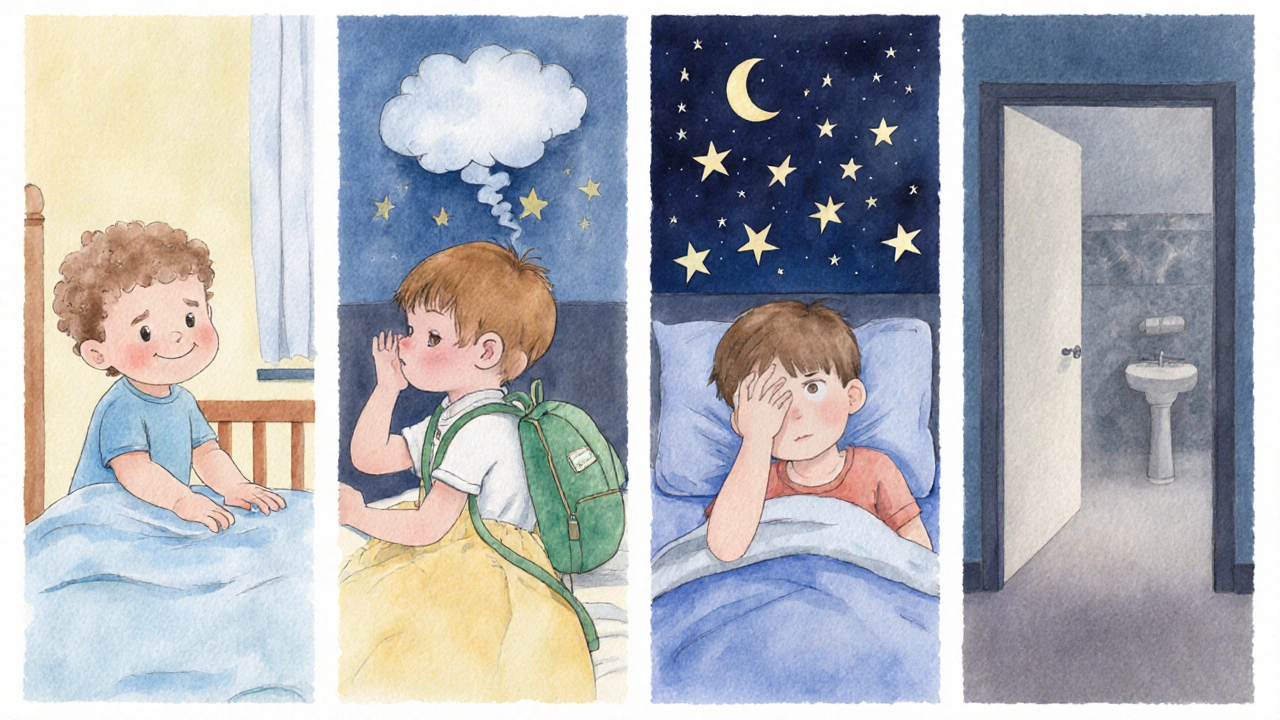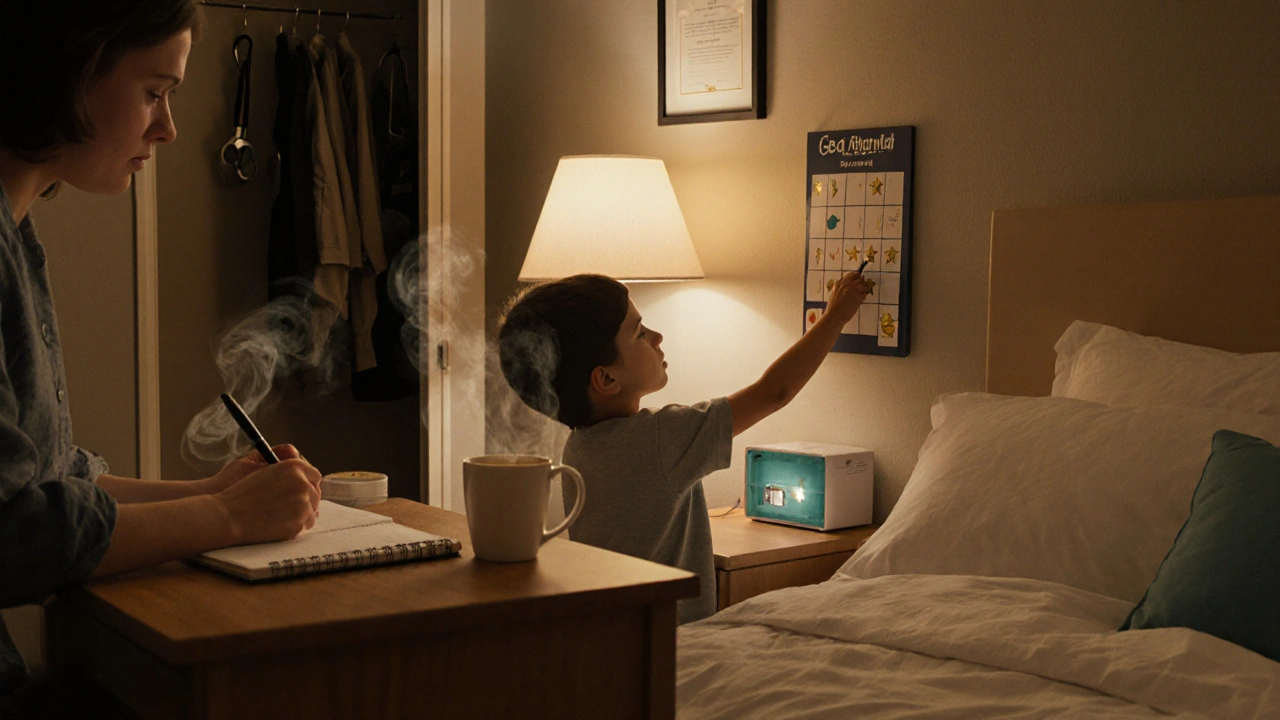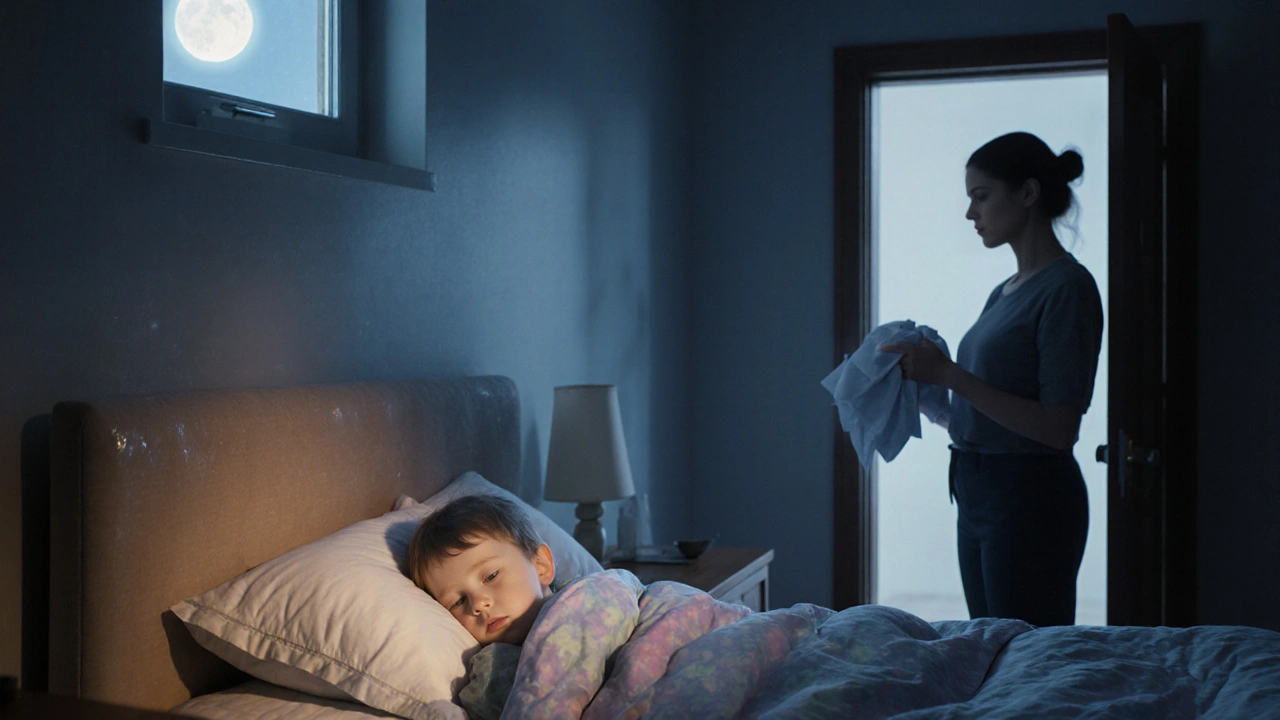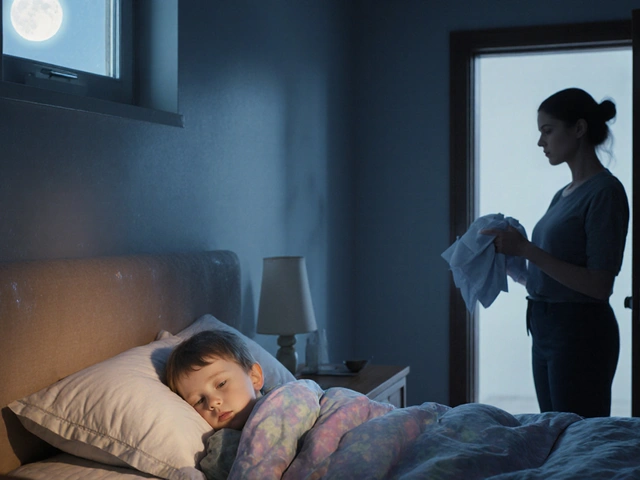Bed-Wetting Type Identifier
Identified Bed-Wetting Type:
Type Information
Primary Nocturnal Enuresis
First-time wetting without prior dry periods. Common in young children.
Young Age No Daytime SymptomsSecondary Nocturnal Enuresis
Relapse after being dry for 6+ months. Often linked to triggers.
Recent Change Stress/InfectionMonosymptomatic (MSNE)
Nighttime wetting only with no daytime issues.
No Daytime Symptoms Age 5-10Non-Monosymptomatic (NMNE)
Nighttime wetting with daytime urinary problems.
Daytime Symptoms ConstipationQuick takeaways
- Bed‑wetting (nocturnal enuresis) splits into primary, secondary, monosymptomatic and non‑monosymptomatic forms.
- Genetics, hormone levels, bladder capacity and sleep depth are the biggest drivers.
- Infections, constipation and stress can turn a harmless night‑time leak into a chronic problem.
- Keeping a wet‑night diary and getting a medical check‑up are the first steps toward a solution.
- Behavioural tools, alarms and, when needed, medication can all help restore dry nights.
If you’re staring at a freshly‑soaked mattress wondering why it keeps happening, you’re not alone. bed-wetting affects millions of children and even some adults, and the reasons range from simple to complex. This guide breaks down every major type, uncovers the most common causes, and gives you a clear plan to move from mystery to management.
What is bed‑wetting?
Bed‑wetting a condition where urine is released involuntarily during sleep, medically known as nocturnal enuresis is more than a “big kid” problem. It can signal an immature bladder, hormonal imbalance, or an underlying medical issue. While occasional accidents are normal for toddlers, persistent wet nights beyond the ages of five or six usually require a closer look.
Main types of bed‑wetting
Understanding the label your doctor uses is half the battle. Below are the most widely recognised categories.
Primary nocturnal enuresis
Primary nocturnal enuresis the first occurrence of regular night‑time wetting in a child who has never achieved a sustained dry period typically shows up before age five and may continue into the teen years. The bladder often hasn’t learned to hold a full night’s urine load.
Secondary nocturnal enuresis
Secondary nocturnal enuresis a relapse into regular bed‑wetting after at least six months of dryness often flags stress, infection, or a new medical condition. It’s a red flag that something has changed.
Monosymptomatic nocturnal enuresis (MSNE)
Monosymptomatic nocturnal enuresis night‑time wetting without any daytime urinary symptoms is the purest form. The child’s bladder functions normally during the day, so treatment focuses on night‑time mechanisms.
Non‑monosymptomatic nocturnal enuresis (NMNE)
Non‑monosymptomatic nocturnal enuresis night‑time wetting accompanied by daytime urinary issues such as urgency or frequency usually points to a bladder or bowel problem that needs addressing both day and night.
Daytime urinary incontinence (functional)
Although not strictly “bed‑wetting,” daytime urinary incontinence involuntary urine loss during waking hours, often due to functional or behavioural factors can spill over into night‑time accidents when the child’s bladder is already over‑active.
Overflow wetting
Overflow wetting urine leakage caused by chronic bladder over‑distension, often linked to constipation or neurological blockage tends to be constant rather than episodic, and it may require specialist assessment.
Common underlying causes
Each type has its own pattern of triggers. Below you’ll find the most frequent culprits.
Genetics & family history
Children with a parent who wet the bed as a child are two to three times more likely to experience the same problem. The heritability factor suggests that bladder‑control genes play a big role.
Hormonal factors - antidiuretic hormone (ADH)
Antidiuretic hormone also known as vasopressin, it reduces urine production at night often peaks later in childhood. Kids with low nighttime ADH levels produce more urine while they sleep, overwhelming a still‑small bladder.
Bladder capacity & maturity
A child’s bladder typically expands to hold about 150ml by age five. If capacity stays below that threshold, the night‑time urine volume can exceed the bladder’s limit, causing a leak.
Sleep depth & arousal thresholds
Deep sleepers may not wake when the bladder signals the need to go. Studies show that children who achieve “slow‑wave sleep” more often have primary enuresis.
Urinary tract infection (UTI)
Urinary tract infection bacterial infection of the urinary system that can irritate the bladder and increase urgency can turn a previously dry night into a wet one almost overnight.
Constipation & bowel‑bladder cross‑talk
Constipation chronic stool retention that presses on the bladder, reducing its functional capacity is a hidden driver of both NMNE and overflow wetting.
Neurological or structural issues
Spinal cord malformations, meningomyelocele, or even mild head injuries can disrupt the signal pathway that tells the brain the bladder is full.
Emotional stress and life changes
Moving house, parental divorce, starting a new school, or any major upheaval can trigger secondary enuresis. The body reacts to stress by altering sleep patterns and bladder control.
Medication side‑effects
Some antihistamines, diuretics, and even certain antidepressants increase urine output or relax bladder muscles, making night‑time accidents more likely.

How to differentiate the types - a quick checklist
- Has the child ever had a dry stretch of six months or more? No→Primary. Yes→look for secondary triggers.
- Are there daytime symptoms (urgency, frequency, pain)? Yes→Non‑monosymptomatic or daytime incontinence.
- Is the problem confined to night‑time only? Yes→Monosymptomatic (MSNE).
- Is there a history of constipation, abdominal bloating, or hard stools? Yes→consider overflow wetting or NMNE.
- Has there been a recent infection, stress event, or new medication? Yes→investigate secondary causes.
Practical steps for parents and caregivers
Knowing the type and likely cause sets up a treatment plan. Here’s a roadmap you can follow.
1. Keep a wet‑night diary
Record the date, amount (dry, light, heavy), any daytime symptoms, fluid intake after dinner, and notable stressors. Patterns emerge after a week or two.
2. Seek a medical evaluation
Bring the diary to a pediatrician or GP. They’ll check for UTIs (urine dipstick), rule out diabetes (blood glucose), assess constipation, and may request a kidney‑bladder ultrasound if structural concerns exist.
3. Behavioural strategies
- Fluid management: Limit drinks after 7pm, especially caffeinated or sugary beverages.
- Scheduled bathroom trips: Wake the child once around 10pm to empty the bladder.
- Positive reinforcement: Sticker charts for dry nights (avoid shame).
4. Bed‑wetting alarms
These devices detect moisture and sound an alarm, training the brain to wake before a full bladder. Success rates climb to 70% after 3‑4 months of consistent use.
5. Medication options (when needed)
Desmopressin (synthetic ADH) reduces nighttime urine production. It works best for children with low ADH levels and for short‑term situations like sleepovers. Always use under doctor supervision.
6. Lifestyle tweaks
- Increase fiber intake (fruits, whole grains) to combat constipation.
- Encourage regular bathroom habits during the day to improve bladder training.
- Address stress with open conversation, counseling, or calming bedtime routines.
Comparison of common bed‑wetting types
| Type | Typical age of onset | Daytime symptoms | Common causes | First‑line approach |
|---|---|---|---|---|
| Primary nocturnal enuresis | Under 5years | None | Low ADH, small bladder, deep sleep | Fluid timing, alarm, bladder training |
| Secondary nocturnal enuresis | Any age after 6months of dryness | May appear | UTI, stress, medication, constipation | Medical check‑up, treat trigger |
| Monosymptomatic (MSNE) | 5‑10years | None | Genetics, ADH deficiency | Alarm or desmopressin |
| Non‑monosymptomatic (NMNE) | 4‑12years | Urgency, frequency, daytime incontinence | Constipation, bladder over‑activity | Treat constipation, bladder retraining |
| Overflow wetting | Variable | Constant dribbling, abdominal discomfort | Severe constipation, neurogenic bladder | Resolve bowel issue, specialist referral |
When to seek specialist help
If any of the following apply, book a urology or pediatric nephrology appointment:
- Wet nights persist beyond age 10years despite basic measures.
- Kidney pain, blood in urine, or recurrent UTIs.
- Severe constipation that doesn’t improve with diet.
- Neurological symptoms (weakness, abnormal gait).
Bottom line
Understanding which type of bed‑wetting you’re dealing with narrows down the cause, which in turn points to the most effective remedy. Keep records, rule out medical issues, and use proven tools like alarms or desmopressin under professional guidance. With the right plan, dry mornings become the new normal.

Frequently Asked Questions
What age is it normal for a child to stop wetting the bed?
Most children outgrow primary enuresis by age 5‑6. By age 10, only about 2% still wet the bed, so persistent night‑time accidents after that merit a medical review.
Can an adult develop bed‑wetting?
Yes. In adults, new‑onset enuresis often signals underlying conditions such as sleep apnea, diabetes, prostate issues, or medication side‑effects. A doctor’s evaluation is essential.
How effective are bed‑wetting alarms?
When used consistently for 3‑4 months, alarms achieve a 70‑80% success rate in establishing dry nights, especially for monosymptomatic cases.
Is desmopressin safe for long‑term use?
Desmopressin is safe for short‑term or occasional use (e.g., sleepovers). Long‑term daily use can increase the risk of low sodium levels, so regular monitoring is required.
Can constipation really cause night‑time wetting?
Absolutely. Chronic stool retention presses on the bladder, lowering its functional capacity and triggering both daytime leakage and secondary nocturnal enuresis.


Oh, the night whispers its secret tides, and the poor child is caught in a tidal wave of droplets-an epic saga of bladders that refuse to cooperate, painting the sheets with the hues of rebellion!
Look, the data doesn't lie: most of these so‑called “types” are just euphemisms for a simple physiologic lag, and the article’s fluff masks the fact that parental anxiety is the real culprit.
First and foremost, it is essential to recognize that nocturnal enuresis is not merely a nuisance but a complex interplay of genetics, neurophysiology, and environmental stressors, each contributing its own shade to the tapestry of night‑time accidents.
When parents embark on the journey of diagnosis, they must gather a comprehensive history that spans not only the frequency of wet nights but also the subtleties of daytime urinary patterns, such as urgency or hesitancy.
The distinction between primary and secondary enuresis hinges on whether the child has ever achieved a sustained period of dryness, a factor that can dramatically alter therapeutic approaches.
Primary nocturnal enuresis often reflects delayed maturation of the central nervous system’s ability to secrete antidiuretic hormone (ADH) during sleep, leading to higher urine production at night.
In contrast, secondary enuresis usually signals an external trigger-perhaps a stressful life event, a recent urinary tract infection, or even a new medication that irritates the bladder wall.
Monosymptomatic nocturnal enuresis (MSNE) isolates the problem to nighttime, suggesting that daytime bladder function is intact, which can be reassuring for families seeking targeted interventions.
Non‑monosymptomatic nocturnal enuresis (NMNE), however, paints a more intricate picture, intertwining night‑time wetting with daytime symptoms like constipation, overactive bladder, or daytime urgency, demanding a broader treatment strategy.
Behavioral modifications, such as fluid restriction in the evening and scheduled bathroom trips before bedtime, remain cornerstone interventions for many children.
Pharmacologic options, including desmopressin for ADH deficiency or anticholinergics for overactive bladder, should be tailored to the specific subtype and individual child’s response.
Moreover, family dynamics play a pivotal role; a supportive, non‑shaming environment can boost a child’s confidence and reduce the psychological burden associated with bed‑wetting.
It is also worth noting that cultural attitudes toward nocturnal enuresis vary, and clinicians must navigate these sensibilities with empathy and respect.
Some families may pursue alternative therapies, such as acupuncture or herbal supplements, which necessitates an open dialogue to ensure safety and efficacy.
Follow‑up is crucial, as many children outgrow nocturnal enuresis naturally, but persistent cases may warrant referral to a pediatric urologist or nephrologist for further evaluation.
In summary, the key to unraveling the mystery of bed‑wetting lies in a thorough, individualized assessment that integrates medical, psychological, and social dimensions, ultimately guiding families toward a tailored, compassionate care plan.
Absolutely, your thorough breakdown hits all the right notes, and I’d like to add that involving the whole family in the nightly routine-like a calming bedtime story and a gentle reminder to use the bathroom-can transform the whole experience from a stressful ordeal into a collaborative adventure, fostering confidence while simultaneously addressing any lingering anxiety the child might feel about the process.
Utilizing a multidisciplinary approach-pediatric nephrology, behavioral therapy, plus a dash of nutritional counseling-optimizes outcomes; however, the implementation requires careful stakeholder alignment, resource allocation, and continuous KPI monitoring to ensure adherence and efficacy.
The guidelines suggest a stepwise protocol that starts with a voiding diary, proceeds to behavioral interventions, and only then considers pharmacotherapy 😊.
From an inclusive standpoint, it’s vital that we recognize the heterogeneity of patient experiences and ensure that educational materials are both culturally sensitive and linguistically accessible, thereby promoting health equity while simultaneously empowering caregivers with evidence‑based strategies that encompass fluid management, alarm therapy integration, and psychosocial support mechanisms.
Ah, yes, because the sheer marvel of a child wetting the bed is the pinnacle of modern medical breakthroughs-truly, we should all bow down to the genius of labeling every minor variation with an elaborate taxonomy.
Well, if we’re handing out fancy titles for every little thing, perhaps we ought to start calling the occasional snooze‑button mishap “temporary nocturnal inconvenience” and reserve the real science for the elite few who can decipher the hidden meanings behind a single wet sheet.
I love how the guide breaks down each type; I’m curious about how often lifestyle factors like caffeine or screen time before bed actually tip the scales toward secondary enuresis.
When we contemplate the night as a canvas upon which subconscious anxieties paint their droplets, we uncover a profound dialogue between body and mind, reminding us that every wet pillow is not merely a symptom but a silent echo of deeper, perhaps unresolved, internal narratives.
That perspective adds a thoughtful layer to the discussion.
Bridging the gap between clinical terminology and community understanding, we must translate concepts like “antidiuretic hormone regulation” into relatable analogies, ensuring that families across diverse cultural backgrounds feel both respected and empowered in managing nocturnal enuresis.
Honestly, most of these so‑called “guidelines” are just a front-big pharma pushes meds while the real hidden agenda is to keep us dependent on endless prescriptions, all under the guise of scientific rigor.
Bed‑wetting often improves with time and consistent bedtime routines.
It’s amusing how the mainstream medical community pretends ignorance while the true cure lies buried in ancient texts, concealed by a cabal of elite practitioners who profit from our ignorance.
Good summary.